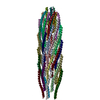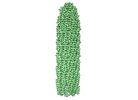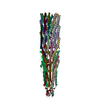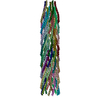+ データを開く
データを開く
- 基本情報
基本情報
| 登録情報 |  | |||||||||
|---|---|---|---|---|---|---|---|---|---|---|
| タイトル | CryoEM structure of the round tip (proteins pVII/pVIII/pIX) from the f1 filamentous bacteriophage | |||||||||
 マップデータ マップデータ | ||||||||||
 試料 試料 |
| |||||||||
 キーワード キーワード | Viral proteins / assembly / VIRUS | |||||||||
| 機能・相同性 |  機能・相同性情報 機能・相同性情報 | |||||||||
| 生物種 |  Enterobacteria phage f1 (ファージ) Enterobacteria phage f1 (ファージ) | |||||||||
| 手法 | 単粒子再構成法 / クライオ電子顕微鏡法 / 解像度: 2.81 Å | |||||||||
 データ登録者 データ登録者 | Conners R / McLaren M / Gold VAM | |||||||||
| 資金援助 |  英国, 1件 英国, 1件
| |||||||||
 引用 引用 |  ジャーナル: Nat Commun / 年: 2023 ジャーナル: Nat Commun / 年: 2023タイトル: Cryo-electron microscopy of the f1 filamentous phage reveals insights into viral infection and assembly. 著者: Rebecca Conners / Rayén Ignacia León-Quezada / Mathew McLaren / Nicholas J Bennett / Bertram Daum / Jasna Rakonjac / Vicki A M Gold /   要旨: Phages are viruses that infect bacteria and dominate every ecosystem on our planet. As well as impacting microbial ecology, physiology and evolution, phages are exploited as tools in molecular ...Phages are viruses that infect bacteria and dominate every ecosystem on our planet. As well as impacting microbial ecology, physiology and evolution, phages are exploited as tools in molecular biology and biotechnology. This is particularly true for the Ff (f1, fd or M13) phages, which represent a widely distributed group of filamentous viruses. Over nearly five decades, Ffs have seen an extraordinary range of applications, yet the complete structure of the phage capsid and consequently the mechanisms of infection and assembly remain largely mysterious. In this work, we use cryo-electron microscopy and a highly efficient system for production of short Ff-derived nanorods to determine a structure of a filamentous virus including the tips. We show that structure combined with mutagenesis can identify phage domains that are important in bacterial attack and for release of new progeny, allowing new models to be proposed for the phage lifecycle. | |||||||||
| 履歴 |
|
- 構造の表示
構造の表示
| 添付画像 |
|---|
- ダウンロードとリンク
ダウンロードとリンク
-EMDBアーカイブ
| マップデータ |  emd_15832.map.gz emd_15832.map.gz | 108.6 MB |  EMDBマップデータ形式 EMDBマップデータ形式 | |
|---|---|---|---|---|
| ヘッダ (付随情報) |  emd-15832-v30.xml emd-15832-v30.xml emd-15832.xml emd-15832.xml | 17.4 KB 17.4 KB | 表示 表示 |  EMDBヘッダ EMDBヘッダ |
| FSC (解像度算出) |  emd_15832_fsc.xml emd_15832_fsc.xml | 13.3 KB | 表示 |  FSCデータファイル FSCデータファイル |
| 画像 |  emd_15832.png emd_15832.png | 51.9 KB | ||
| Filedesc metadata |  emd-15832.cif.gz emd-15832.cif.gz | 5.5 KB | ||
| その他 |  emd_15832_half_map_1.map.gz emd_15832_half_map_1.map.gz emd_15832_half_map_2.map.gz emd_15832_half_map_2.map.gz | 200.3 MB 200.3 MB | ||
| アーカイブディレクトリ |  http://ftp.pdbj.org/pub/emdb/structures/EMD-15832 http://ftp.pdbj.org/pub/emdb/structures/EMD-15832 ftp://ftp.pdbj.org/pub/emdb/structures/EMD-15832 ftp://ftp.pdbj.org/pub/emdb/structures/EMD-15832 | HTTPS FTP |
-検証レポート
| 文書・要旨 |  emd_15832_validation.pdf.gz emd_15832_validation.pdf.gz | 735.1 KB | 表示 |  EMDB検証レポート EMDB検証レポート |
|---|---|---|---|---|
| 文書・詳細版 |  emd_15832_full_validation.pdf.gz emd_15832_full_validation.pdf.gz | 734.7 KB | 表示 | |
| XML形式データ |  emd_15832_validation.xml.gz emd_15832_validation.xml.gz | 21.6 KB | 表示 | |
| CIF形式データ |  emd_15832_validation.cif.gz emd_15832_validation.cif.gz | 28.2 KB | 表示 | |
| アーカイブディレクトリ |  https://ftp.pdbj.org/pub/emdb/validation_reports/EMD-15832 https://ftp.pdbj.org/pub/emdb/validation_reports/EMD-15832 ftp://ftp.pdbj.org/pub/emdb/validation_reports/EMD-15832 ftp://ftp.pdbj.org/pub/emdb/validation_reports/EMD-15832 | HTTPS FTP |
-関連構造データ
- リンク
リンク
| EMDBのページ |  EMDB (EBI/PDBe) / EMDB (EBI/PDBe) /  EMDataResource EMDataResource |
|---|
- マップ
マップ
| ファイル |  ダウンロード / ファイル: emd_15832.map.gz / 形式: CCP4 / 大きさ: 216 MB / タイプ: IMAGE STORED AS FLOATING POINT NUMBER (4 BYTES) ダウンロード / ファイル: emd_15832.map.gz / 形式: CCP4 / 大きさ: 216 MB / タイプ: IMAGE STORED AS FLOATING POINT NUMBER (4 BYTES) | ||||||||||||||||||||||||||||||||||||
|---|---|---|---|---|---|---|---|---|---|---|---|---|---|---|---|---|---|---|---|---|---|---|---|---|---|---|---|---|---|---|---|---|---|---|---|---|---|
| 投影像・断面図 | 画像のコントロール
画像は Spider により作成 | ||||||||||||||||||||||||||||||||||||
| ボクセルのサイズ | X=Y=Z: 1.1012 Å | ||||||||||||||||||||||||||||||||||||
| 密度 |
| ||||||||||||||||||||||||||||||||||||
| 対称性 | 空間群: 1 | ||||||||||||||||||||||||||||||||||||
| 詳細 | EMDB XML:
|
-添付データ
-ハーフマップ: #1
| ファイル | emd_15832_half_map_1.map | ||||||||||||
|---|---|---|---|---|---|---|---|---|---|---|---|---|---|
| 投影像・断面図 |
| ||||||||||||
| 密度ヒストグラム |
-ハーフマップ: #2
| ファイル | emd_15832_half_map_2.map | ||||||||||||
|---|---|---|---|---|---|---|---|---|---|---|---|---|---|
| 投影像・断面図 |
| ||||||||||||
| 密度ヒストグラム |
- 試料の構成要素
試料の構成要素
-全体 : Enterobacteria phage f1
| 全体 | 名称:  Enterobacteria phage f1 (ファージ) Enterobacteria phage f1 (ファージ) |
|---|---|
| 要素 |
|
-超分子 #1: Enterobacteria phage f1
| 超分子 | 名称: Enterobacteria phage f1 / タイプ: virus / ID: 1 / 親要素: 0 / 含まれる分子: all / NCBI-ID: 10863 / 生物種: Enterobacteria phage f1 / ウイルスタイプ: VIRION / ウイルス・単離状態: OTHER / ウイルス・エンベロープ: No / ウイルス・中空状態: No |
|---|---|
| 宿主 | 生物種:  |
-分子 #1: Tail virion protein G7P
| 分子 | 名称: Tail virion protein G7P / タイプ: protein_or_peptide / ID: 1 / コピー数: 5 / 光学異性体: LEVO |
|---|---|
| 由来(天然) | 生物種:  Enterobacteria phage f1 (ファージ) Enterobacteria phage f1 (ファージ) |
| 分子量 | 理論値: 3.603215 KDa |
| 組換発現 | 生物種:  |
| 配列 | 文字列: MEQVADFDTI YQAMIQISVV LCFALGIIAG GQR UniProtKB: Tail virion protein G7P |
-分子 #2: Tail virion protein G9P
| 分子 | 名称: Tail virion protein G9P / タイプ: protein_or_peptide / ID: 2 / コピー数: 5 / 光学異性体: LEVO |
|---|---|
| 由来(天然) | 生物種:  Enterobacteria phage f1 (ファージ) Enterobacteria phage f1 (ファージ) |
| 分子量 | 理論値: 3.65527 KDa |
| 組換発現 | 生物種:  |
| 配列 | 文字列: MSVLVYSFAS FVLGWCLRSG ITYFTRLMET SS UniProtKB: Tail virion protein G9P |
-分子 #3: Capsid protein G8P
| 分子 | 名称: Capsid protein G8P / タイプ: protein_or_peptide / ID: 3 / コピー数: 45 / 光学異性体: LEVO |
|---|---|
| 由来(天然) | 生物種:  Enterobacteria phage f1 (ファージ) Enterobacteria phage f1 (ファージ) |
| 分子量 | 理論値: 5.212021 KDa |
| 組換発現 | 生物種:  |
| 配列 | 文字列: AEGDDPAKAA FDSLQASATE MIGYAWAMVV VIVGATIGIK LFKKFTSKAS UniProtKB: Capsid protein G8P |
-実験情報
-構造解析
| 手法 | クライオ電子顕微鏡法 |
|---|---|
 解析 解析 | 単粒子再構成法 |
| 試料の集合状態 | particle |
- 試料調製
試料調製
| 緩衝液 | pH: 8 |
|---|---|
| グリッド | モデル: Quantifoil R1.2/1.3 / 材質: COPPER / メッシュ: 300 / 支持フィルム - 材質: CARBON / 支持フィルム - トポロジー: HOLEY / 前処理 - タイプ: GLOW DISCHARGE |
| 凍結 | 凍結剤: ETHANE / チャンバー内湿度: 100 % / チャンバー内温度: 277 K / 装置: FEI VITROBOT MARK IV 詳細: Wait time 5 sec., drain time 0 sec., blot force 0, blot time 4 sec.. |
- 電子顕微鏡法
電子顕微鏡法
| 顕微鏡 | TFS KRIOS |
|---|---|
| 撮影 | フィルム・検出器のモデル: GATAN K3 BIOQUANTUM (6k x 4k) 平均電子線量: 40.0 e/Å2 |
| 電子線 | 加速電圧: 300 kV / 電子線源:  FIELD EMISSION GUN FIELD EMISSION GUN |
| 電子光学系 | 照射モード: FLOOD BEAM / 撮影モード: BRIGHT FIELD / 最大 デフォーカス(公称値): 2.5 µm / 最小 デフォーカス(公称値): 1.3 µm |
| 実験機器 |  モデル: Titan Krios / 画像提供: FEI Company |
+ 画像解析
画像解析
-原子モデル構築 1
| 精密化 | プロトコル: OTHER |
|---|---|
| 得られたモデル |  PDB-8b3p: |
 ムービー
ムービー コントローラー
コントローラー








 Z (Sec.)
Z (Sec.) Y (Row.)
Y (Row.) X (Col.)
X (Col.)





































